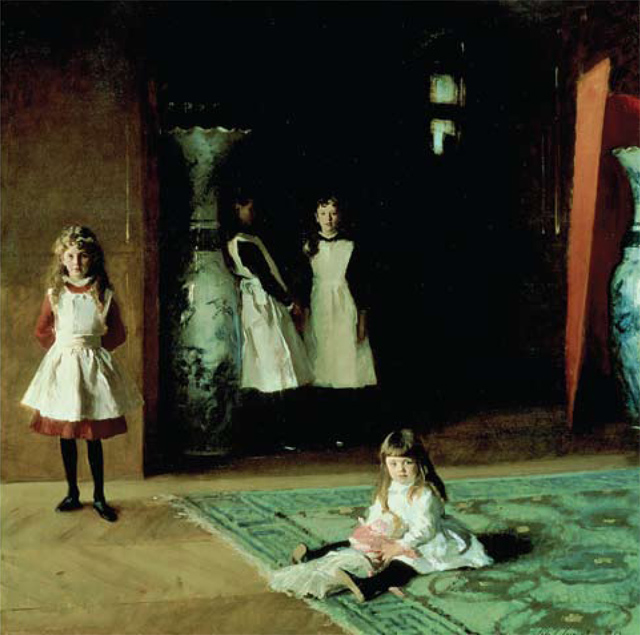My Favourite Painting: Craig Brown
Craig Brown chooses his favourite painting for Country Life.


The Daughters of Edward Darley Boit, 1882, 871/4in by 871/2in, by John Singer Sargent (1856–1925), Museum of Fine Arts, Boston. Bridgeman Images.
Craig Brown says: ‘I first came upon this painting when walking around the Boston Museum of Fine Arts. It stopped me in my tracks. These four girls–the daughters of a rich fellow artist–stare out of the canvas with melancholy, as if trapped like butterflies by time. Sargent always had an amazing facility, but this painting has the additional air of mystery that so often defines a great work of art.’
Craig Brown is a critic and satirist, and a regular contributor to Private Eye.
Art critic John McEwen comments: 'I used to scandalise my sober teachers by telling them I admired Sargent,’ said the late Victor Willing of his days at the Slade in the early 1950s. Teachers fashionably tarred by Marxism were blind to the merits of anyone who painted the rich. Sargent’s return to academic favour began a decade before the fall of Communism. Now, this masterpiece hangs on temporary loan in the Prado beside the larger Las Meninas, which Sargent copied in the Madrid gallery.
Velázquez was the rage when the Florence-born but American student was learning his craft at the atelier of Carolus-Duran in Paris. As a cosmopolitan American, fluent in French and Italian and highly musical, Sargent was pure Henry James, so who better to describe this portrait than the master novelist himself? James first met Sargent through Mrs Boit herself. ‘The naturalness of the composition, the loveliness of the complete effect, the light, free security of the execution, the sense it gives us of assimilated secrets and of instinct and knowledge playing together—all this makes the picture…[an] astonishing… work on the part of a young man of twenty six.’
None of the girls married, the two eldest grew to be ‘emotionally disturbed’, the youngest, Julia, was the last to die, in 1969. The Japanese vases are still in the family. Sargent eventually gave up portraiture—‘I must do something else. I have made so many enemies’. A show of his early paintings, ‘Sargent and the Sea’, is at the RA until September 26. ‘Victor Willing’ is at Casa das Histórias, Cascais, Portugal, from September 10.'
This article was first published in Country Life, July 28, 2010
Sign up for the Country Life Newsletter
Exquisite houses, the beauty of Nature, and how to get the most from your life, straight to your inbox.
Country Life is unlike any other magazine: the only glossy weekly on the newsstand and the only magazine that has been guest-edited by HRH The King not once, but twice. It is a celebration of modern rural life and all its diverse joys and pleasures — that was first published in Queen Victoria's Diamond Jubilee year. Our eclectic mixture of witty and informative content — from the most up-to-date property news and commentary and a coveted glimpse inside some of the UK's best houses and gardens, to gardening, the arts and interior design, written by experts in their field — still cannot be found in print or online, anywhere else.
-
 ‘It had the air of an ex-rental, and that’s putting it politely’: How an antique dealer transformed a run-down Georgian house in Chatham Dockyards
‘It had the air of an ex-rental, and that’s putting it politely’: How an antique dealer transformed a run-down Georgian house in Chatham DockyardsAn antique dealer with an eye for colour has rescued an 18th-century house from years of neglect with the help of the team at Mylands.
By Arabella Youens
-
 You're having a giraffe: Country Life Quiz of the Day, April 25, 2025
You're having a giraffe: Country Life Quiz of the Day, April 25, 2025Friday's Quiz of the Day brings your opera, marathons and a Spanish landmark.
By Toby Keel
-
 My favourite painting: Allan Mallinson
My favourite painting: Allan MallinsonMilitary historian Allan Mallinson picks an image of 'faith, generosity and ultimate sacrifice'.
By Charlotte Mullins
-
 My Favourite Painting: Piet Oudolf
My Favourite Painting: Piet Oudolf'One cannot sense whether he is far out on the ocean or closer to shore, or what he may be watching or feeling in that moment as he stares towards the beach.’
By Country Life
-
 My Favourite Painting: Mary Plazas
My Favourite Painting: Mary Plazas'There is compassion, awe, humility, a knowing yet a questioning in the glistening eyes. It moves me, it inspires me beyond the need to know.’
By Country Life
-
 My favourite painting: Robert Kime
My favourite painting: Robert KimeRobert Kime shares his fondness for New Year Snow by Ravilious
By Country Life
-
 My Favourite Painting: Anna Pavord
My Favourite Painting: Anna PavordAnna Pavord chooses a picture which reminds her of where she grew up
By Country Life
-
 My favourite painting: The Duchess of Wellington
My favourite painting: The Duchess of WellingtonThe Duchess of Wellington chooses her favourite painting for Country Life.
By Country Life
-
 My favourite painting: Maureen Lipman
My favourite painting: Maureen LipmanMaureen Lipman chooses her favourite painting for Country Life.
By Country Life
-
 My favourite painting: Jacqueline Wilson
My favourite painting: Jacqueline Wilson'I looked at this painting and decided to write about a Victorian circus girl one day'
By Country Life